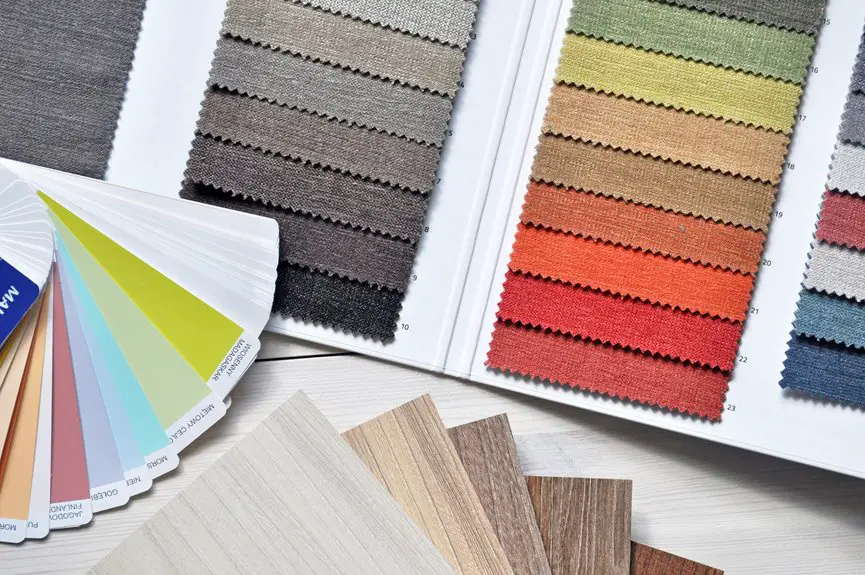Certain fabrics stink more than others due to their fiber content and moisture retention properties. Natural fibers like cotton and wool breathe better, allowing moisture to escape and reducing odors. In contrast, synthetic fabrics trap sweat and can encourage the growth of odor-causing bacteria. This leads to unpleasant smells that cling to your clothes. Understanding these factors can help you make better choices for fresh-smelling fabrics. There’s a lot more to discover about keeping your clothes odor-free.
Table of Contents
Key Takeaways
- Natural fibers like cotton and wool are more breathable, allowing moisture to escape and reducing odor retention compared to synthetic fibers.
- Synthetic fabrics, such as polyester, trap moisture and sweat, creating an environment conducive to bacterial growth and stronger odors.
- Different types of bacteria produce distinct odors, with some fabrics more prone to specific bacteria that cause unpleasant smells.
- Moisture-wicking fabrics help keep sweat away from the skin, minimizing odor retention during physical activities.
- Regular washing and proper care are essential to prevent odor buildup, as damp fabrics promote mildew and bacteria growth.
The Role of Fiber Content
When it comes to fabrics that stink, fiber content plays a crucial role. Different fibers absorb and retain odors in various ways.
For instance, natural fibers like cotton and wool tend to breathe better, allowing some moisture to escape, which can help reduce lingering smells.
On the other hand, synthetic fibers like polyester and nylon often trap sweat and odors, making them more prone to stinking. If you wear synthetic clothing during intense workouts, you might notice a stronger smell afterward compared to natural fabrics.
Synthetic fibers like polyester and nylon can trap sweat and odors, leading to stronger smells during workouts compared to natural fabrics.
Choosing the right fiber content can make a significant difference in odor management.
Moisture Retention and Odor
When you wear fabrics that trap moisture, you’re creating a perfect environment for bacteria to thrive, which can lead to unpleasant odors.
Understanding fabric breathability and moisture-wicking properties is vital for staying fresh.
Let’s explore how these factors impact your comfort and scent.
Fabric Breathability Factors
While you mightn’t think about it often, the breathability of your fabric plays an essential role in how comfortable and fresh you feel throughout the day.
Fabrics that allow air circulation help wick away moisture, reducing the likelihood of unpleasant odors.
Here are a few factors that influence fabric breathability:
- Fiber Composition: Natural fibers like cotton and linen generally breathe better than synthetic options.
- Weave Structure: Looser weaves promote airflow, while tighter weaves can trap heat and moisture.
- Moisture Management: Fabrics designed to wick moisture away from your skin enhance breathability and keep you dry.
Choosing breathable fabrics can make a significant difference in your comfort level and overall freshness, especially during warm weather or intense activities.
Bacteria Growth Environment
Breathable fabrics can help keep you comfortable, but if they retain moisture, they create an ideal environment for bacteria to thrive.
When you sweat, the dampness can cling to your clothing, especially if the fabric isn’t designed to wick away moisture. This moisture serves as a breeding ground for bacteria, which can lead to unpleasant odors.
The more the fabric holds onto that moisture, the more bacteria multiply, making your clothes smell worse over time. Even if you wash the fabric, lingering bacteria can cause persistent odors.
To minimize this, choose fabrics that allow for better evaporation. By doing so, you can help reduce moisture retention and keep those pesky bacteria at bay, ensuring you smell fresh throughout the day.
Moisture Wicking Properties
Choosing fabrics with moisture-wicking properties is essential for staying fresh and comfortable, especially during physical activities.
These fabrics pull sweat away from your skin, helping to regulate your body temperature and reduce odor. Here are a few key benefits of moisture-wicking materials:
- Enhanced Breathability: They allow air to circulate, which helps evaporate sweat quickly.
- Reduced Bacterial Growth: By keeping moisture at bay, these fabrics limit the environment where odor-causing bacteria thrive.
- Increased Comfort: You’ll feel drier and more comfortable, allowing you to focus on your performance rather than unpleasant smells.
Opting for moisture-wicking fabrics can greatly impact your overall experience, ensuring you stay fresh while you work out or go about your day.
Bacteria and Microbial Growth
Many people don’t realize that bacteria and microbial growth are the primary culprits behind the unpleasant odors that can cling to fabrics. When you wear your clothes, sweat and skin cells create an ideal environment for these microorganisms to thrive. As they break down organic matter, they produce smelly byproducts that linger even after washing.
Here’s a quick look at the types of bacteria and their effects:
| Bacteria Type | Odor Produced | Common Fabrics Affected |
|---|---|---|
| Staphylococcus | Sour, pungent | Athletic wear |
| Micrococcus | Musty, earthy | Cotton |
| Corynebacterium | Sharp, tangy | Synthetic blends |
| Brevibacterium | Cheese-like | Wool |
Understanding this can help you choose fabrics that resist odor better!
The Impact of Sweat
When you sweat, the fabric you wear plays an essential role in how that moisture is managed.
Certain materials can trap sweat, leading to unpleasant odors and discomfort.
Understanding the composition of your clothes can help you choose ones that keep you feeling fresh and dry.
Fabric Composition Matters
Although you mightn’t realize it, the fabric composition of your clothes plays an essential role in how they react to sweat.
Different materials interact with perspiration in unique ways, impacting odor retention. Here’s what to evaluate:
- Natural fibers like cotton are breathable but can absorb sweat, leading to lingering smells.
- Synthetics such as polyester wick moisture away but may trap odor-causing bacteria within the fibers.
- Blends often combine the benefits of both, but the ratio of materials can greatly affect odor retention.
Moisture Retention Effects
The way fabrics handle moisture can greatly affect how you smell after a workout or a long day. Some materials trap sweat against your skin, creating the perfect environment for odor-causing bacteria to thrive.
When you wear cotton, for instance, it absorbs moisture but doesn’t dry quickly, which means you might end up smelling sour. On the other hand, moisture-wicking fabrics pull sweat away from your body and dry faster, helping you stay fresher.
If you tend to sweat a lot, opt for synthetic blends designed to combat odor. Remember, the right fabric can make a significant difference in how you feel and smell, especially during those intense activities or long, hot days.
Choose wisely to stay comfortable!
Synthetic vs. Natural Fabrics
While you mightn’t think much about the materials in your clothing, the choice between synthetic and natural fabrics can greatly impact how they smell over time.
The materials in your clothing significantly influence how they smell over time, impacting your overall comfort and freshness.
Synthetic fabrics, like polyester and nylon, tend to trap moisture and odors, making them prone to unpleasant smells. On the other hand, natural fabrics, such as cotton and wool, often allow for better airflow and moisture wicking.
Here are a few key differences:
- Odor retention: Synthetic fabrics hold onto smells more than natural ones.
- Moisture absorption: Natural fabrics absorb moisture, reducing odor build-up.
- Durability: Synthetics can withstand washing better, but at the cost of odor resistance.
Understanding these differences can help you make smarter choices for your wardrobe.
The Importance of Breathability
Breathability plays an essential role in how comfortable your clothing feels and how it performs over time. When you wear breathable fabrics, moisture escapes, and air circulates, keeping you cool and dry. This is especially important during physical activities or hot weather.
If your clothes trap heat and sweat, you not only feel uncomfortable, but odor can build up, making fabrics stink faster. Natural fibers like cotton and linen typically offer better breathability compared to synthetic materials, allowing your skin to breathe.
Choosing breathable fabrics means you’re investing in your comfort and hygiene, reducing the chances of unpleasant smells. So, next time you shop for clothes, consider breathability as a key factor for both comfort and freshness.
Washing and Care Instructions
To keep your fabrics smelling fresh and looking their best, it’s crucial to follow proper washing and care instructions. Neglecting this can lead to lingering odors and unwanted wear.
Proper washing and care are essential for keeping fabrics fresh and preventing odors and wear.
Here are a few tips to maintain your fabrics:
- Wash regularly: Don’t wait until your clothes smell bad; regular washing prevents odor buildup.
- Use the right detergent: Choose detergents designed to combat odors, especially for synthetic fabrics.
- Dry properly: Make sure your fabrics dry completely to prevent mildew, which can cause unpleasant smells.
Environmental Factors
When it comes to fabrics that stink, environmental factors play a big role.
High humidity and temperature swings can create the perfect conditions for odors to develop, while poor air quality can worsen the situation.
You might be surprised at how much your surroundings influence your clothes’ scent.
Humidity and Moisture Levels
Humidity and moisture levels play a crucial role in how fabrics retain odors. When fabrics absorb moisture, they create an environment where bacteria thrive, leading to unpleasant smells.
You’ve probably noticed that some fabrics seem to stink more after a workout or during humid weather. Here are a few key points to reflect on:
- Moisture Absorption: Fabrics like cotton and wool can hold onto moisture, increasing odor retention.
- Bacteria Growth: Higher humidity levels accelerate bacterial growth, causing odor to develop more rapidly.
- Drying Conditions: In humid environments, fabrics may not dry properly, allowing odors to linger longer.
Temperature Variations
Temperature variations can greatly influence how fabrics retain odors, especially when combined with humidity. When it’s hot, your clothes tend to trap sweat and bacteria more easily, leading to unpleasant smells.
Fabrics like cotton and polyester absorb moisture, which can worsen the odor issue as temperatures rise. On the flip side, cooler temperatures may inhibit bacteria growth, helping fabrics smell fresher for longer.
However, if you wear damp clothes in cold conditions, you might still face odor challenges. The key is to be mindful of the fabric type and the temperature when selecting your wardrobe.
Air Quality Impact
Your wardrobe isn’t just affected by temperature; the air quality around you plays a significant role in how fabrics retain odors. Poor air quality can cause fabrics to absorb and hold onto unpleasant smells, making your clothes less appealing.
Here are some factors to evaluate:
- Humidity Levels: High humidity can promote mold and mildew, leading to musty odors in your clothes.
- Pollution: Airborne pollutants and chemicals can cling to fibers, creating a stale smell that’s hard to eliminate.
- Indoor Environment: Poor ventilation in your home can trap odors, allowing them to permeate your fabrics over time.
Being mindful of these aspects can help you choose and care for fabrics that resist odors better, ensuring your wardrobe stays fresh.
Odor-Blocking Technologies
As you explore the world of fabrics, you’ll find that odor-blocking technologies have revolutionized how we tackle unpleasant smells in clothing and textiles.
These innovative solutions work by incorporating antimicrobial agents, which prevent the growth of odor-causing bacteria. You may also encounter fabrics treated with special coatings that absorb and neutralize odors, keeping your garments fresher for longer.
Some brands even use natural fibers infused with essential oils or activated charcoal, effectively combating odors without harsh chemicals.
These advancements not only enhance your comfort but also extend the lifespan of your favorite outfits. By choosing garments with these odor-blocking technologies, you can enjoy your activities without worrying about unwanted smells.
Embrace the future of fabric and stay fresh all day long!
Choosing the Right Fabric for Activities
When selecting the right fabric for specific activities, it’s essential to take into account factors like breathability, moisture-wicking properties, and stretch.
Choosing the right material can enhance your performance and comfort.
- Breathability: Fabrics like cotton and linen allow air circulation, keeping you cool during low-intensity activities.
- Moisture-wicking: Synthetic materials, such as polyester or nylon, draw sweat away from your skin, making them ideal for high-intensity workouts.
- Stretch: Look for materials with spandex or elastane, as they provide flexibility and support during movement.
Frequently Asked Questions
Can Fabric Color Influence Odor Retention?
Yes, fabric color can influence odor retention. Darker colors might absorb more heat, leading to increased bacteria growth and odor. Lighter shades often reflect heat better, potentially reducing odor retention in certain fabrics.
How Does Fabric Texture Affect Smell?
Fabric texture plays a critical role in odor retention. When you wear textured fabrics, they can trap sweat and bacteria more easily, leading to stronger smells. Smoother materials often allow better airflow, reducing odor buildup.
Do Certain Fabrics Hold Onto Smoke Odors?
Ever wondered why some fabrics cling to smoke odors like a persistent memory? Yes, certain materials, especially those with tighter weaves, trap smoke particles more effectively, making it harder for you to eliminate the smell completely.
Does the Age of Fabric Impact Its Odor?
Yes, the age of fabric can impact its odor. As fabrics age, they accumulate dirt, oils, and bacteria, which can lead to unpleasant smells. Regular cleaning can help maintain freshness in older fabrics.
Can Storing Fabrics Improperly Cause Them to Smell?
Storing fabrics improperly can definitely cause them to smell. While fresh, clean fabric might seem fine, dampness or poor ventilation can lead to musty odors. You should always store fabrics in a dry, breathable environment.
- The Use of Nonwovens in Construction and Civil Engineering - July 11, 2025
- The Use of Nonwovens in Construction and Civil Engineering - July 11, 2025
- The Use of Nonwovens in Construction and Civil Engineering - July 11, 2025







